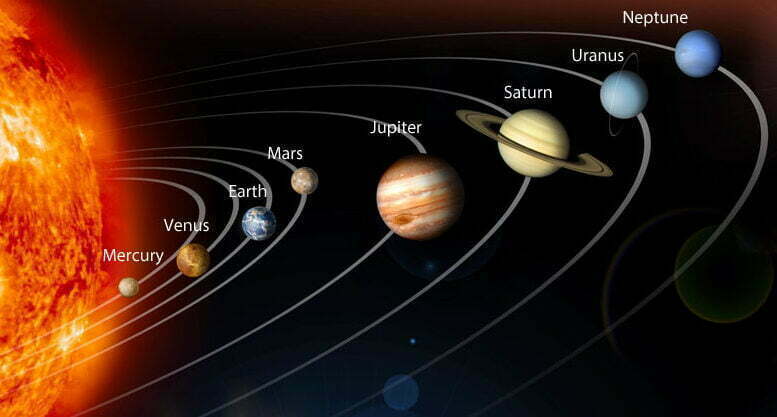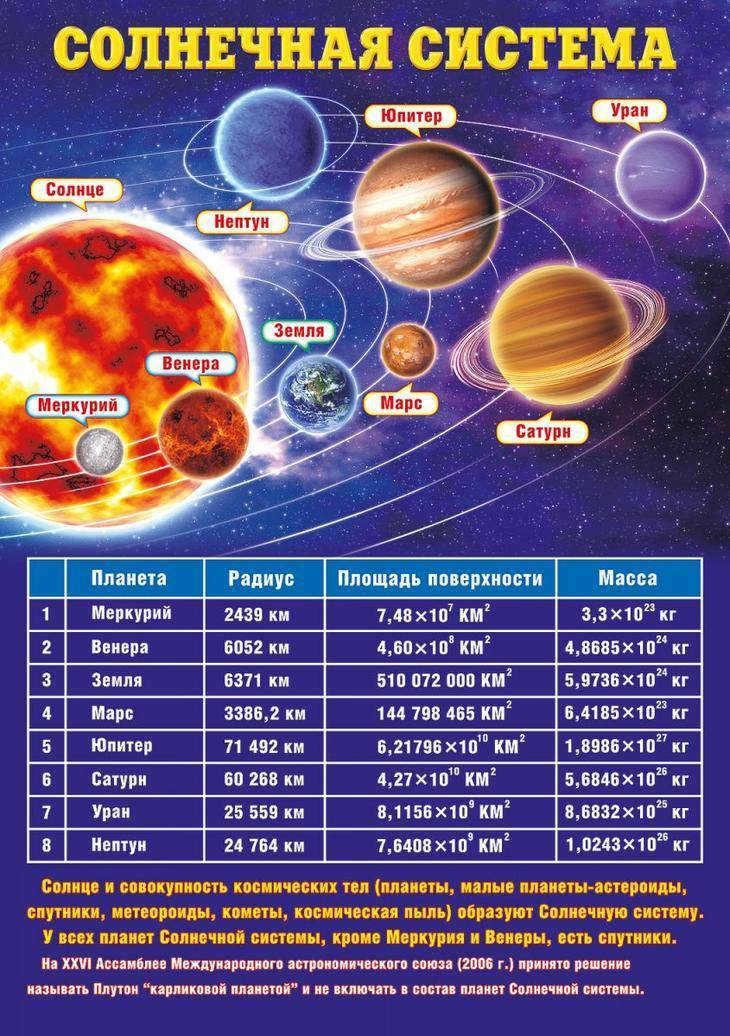
The Proportions of Planets in the Solar System
The Current Ranking of Planets in the Solar System
In 2006, Pluto was demoted from its status as a planet due to the discovery of larger objects in the Kuiper Belt. Therefore, if we consider Pluto as a full-fledged celestial body, we must also include Eridu, which is almost the same size as Pluto, in this category.
The sequence of planets in the solar system
As per the MAC’s classification, there are a total of 8 recognized planets in the solar system, namely Mercury, Venus, Earth, Mars, Jupiter, Saturn, Uranus, and Neptune.
All the planets can be categorized into two groups based on their physical attributes: terrestrial planets and gas giants.
Planets similar to Earth
The planet Mercury
Mercury experiences the most extreme temperature changes among all the planets in our solar system due to its close proximity to the Sun. During the day, the average temperature can reach a scorching 350 degrees Celsius, while at night, it plummets to a bone-chilling -170 °C. Scientists have detected the presence of various elements in its atmosphere, including sodium, oxygen, helium, potassium, hydrogen, and argon. Some researchers speculate that Mercury was once a moon of Venus, but this hypothesis has yet to be confirmed. Notably, Mercury does not have any moons of its own.
Venus
Venus, the second planet from the Sun, boasts an atmosphere that is predominantly composed of carbon dioxide. It is commonly referred to as both the Morning Star and the Evening Star due to its ability to be the first celestial object visible after sunset and the last one before dawn when all other stars have vanished from sight. The atmospheric composition of Venus consists of approximately 96% carbon dioxide, with nitrogen accounting for a relatively small portion of about 4%. In addition, trace amounts of water vapor and oxygen can also be found in the atmosphere.
This unique environment creates a greenhouse effect, resulting in surface temperatures that exceed even those on Mercury, reaching a scorching 475 °C. Known for its leisurely pace, a day on Venus lasts a staggering 243 Earth days, nearly equivalent to a Venusian year of 225 Earth days. Often referred to as Earth’s sibling due to its similar mass and radius, Venus closely resembles our own planet in size. With a radius of 6052 km (just 0.85% of Earth’s), Venus lacks any natural satellites, much like Mercury.
The planet closest to the Sun and the singular one in our solar system that possesses liquid H2O on its exterior, an essential condition for the development of life on the planet. Or at least life as we comprehend it. Earth has a diameter of 6371 kilometers and, unlike the other celestial entities in our solar system, over 70% of its surface is engulfed by water. The remaining expanse is occupied by continents. An additional characteristic of Earth is the presence of tectonic plates concealed beneath the planet’s mantle. These plates possess the capability to shift, however at an extremely gradual pace, resulting in a gradual transformation of the landscape. The velocity at which the planet moves along its orbit is approximately 29-30 kilometers per second.
The Earth takes nearly 24 hours to complete one rotation on its axis and approximately 365 days to complete one orbit around the sun, which is significantly longer in comparison to the planets that are closest in proximity. The duration of a day and a year on Earth are used as a standard for measuring time intervals on other planets for the sake of convenience. Additionally, the Earth is accompanied by one natural satellite, known as the Moon.
Mars
Mars, the fourth planet from the Sun, is well-known for its thin atmosphere. Since 1960, scientists from various countries, including the United States and the USSR, have been actively conducting exploration programs on Mars. While not all of these programs have been successful, the discovery of water in certain areas suggests the possibility of primitive life on Mars, either currently or in the past.
Mars is easily visible from Earth due to its brightness, even without the use of any instruments. During the opposition, which occurs every 15-17 years, Mars becomes the brightest object in the sky, surpassing even Jupiter and Venus.
With a radius of approximately 3390 km, Mars is almost half the size of Earth. However, its year is significantly longer, lasting 687 days. The planet has two satellites, Phobos and Deimos.
A representation of the solar system in images
Caution! The animation will only function in browsers that support the standard -webkit (such as Google Chrome, Opera, or Safari).
The massive planets
There are four enormous gas planets situated beyond the orbit of Mars: Jupiter, Saturn, Uranus, and Neptune. These planets can be found in the outer region of the solar system. They vary in terms of their mass and composition of gases.
Jupiter, the fifth planet from the Sun, is the largest planet in our solar system. With a radius of 69,912 km, it is 19 times bigger than Earth and only 10 times smaller than the Sun. Unlike other planets, Jupiter’s year is not the longest in the solar system. It lasts for 4,333 Earth days, which is equivalent to incomplete 12 Earth years. A day on Jupiter, however, is much shorter, lasting only about 10 Earth hours. The exact composition of Jupiter’s surface is still unknown, but it is believed to contain larger amounts of krypton, argon, and xenon compared to the Sun.
There is a belief that one of the four gas giants is actually a failed star. Supporting this theory is the fact that it has the highest number of satellites, with Jupiter having a total of 67. To comprehend their behavior in the planet’s orbit, a precise and clear model of the solar system is required. The most significant ones are Callisto, Ganymede, Io, and Europa. In particular, Ganymede is the largest satellite among all the planets in the entire solar system, measuring 2634 km in radius, which is 8% larger than Mercury, the smallest planet in our system. Notably, Io is one of the three satellites that possesses an atmosphere.
Saturn
Saturn is the second largest planet and the sixth largest in the solar system. It is known for its similarity to the Sun in terms of chemical composition. With a radius of 57,350 kilometers, Saturn has a year that lasts for 10,759 days, which is almost 30 Earth years. A day on Saturn lasts slightly longer than on Jupiter, at 10.5 Earth hours. Saturn has a total of 62 satellites, just slightly less than its neighbor Jupiter’s 67. The largest satellite of Saturn is Titan, which is known for having an atmosphere. Other notable satellites of Saturn include Io, Enceladus, Rhea, Dione, Tethys, Iapetus, and Mimas. These satellites are the most frequently observed objects and have been extensively studied in comparison to others.
For quite some time, scientists believed that Saturn’s rings were an extraordinary phenomenon exclusive to the planet. However, recent findings have revealed that all gas giants possess rings, although they may not be as prominently visible. The exact origins of these rings remain unknown, although there are several hypotheses surrounding their formation. Additionally, it has been recently discovered that Rhea, one of Saturn’s satellites, also exhibits a semblance of rings.
Uranus
Uranus is the seventh largest planet in our solar system, and it is also the third largest. It has a radius of 25267 km. One of the most notable features of Uranus is its extreme coldness, with temperatures dropping as low as -224 degrees Celsius. In terms of Earth days, Uranus has a year that lasts for 30,685 days, which is equivalent to almost 84 years. The length of a day on Uranus is also quite similar to Earth’s, lasting around 17 hours.
One interesting characteristic of Uranus is its unique rotation. Due to the strong inclination of its axis, it may appear as if Uranus does not rotate like other celestial bodies in our solar system. Instead, it rolls like a ball. This can be easily observed by anyone with an interest in astronomy. A geometric model of the solar system will clearly demonstrate this effect.
Unlike its neighboring planet Saturn, Uranus has far fewer satellites. In fact, it only has 27 satellites. Some of the most well-known satellites of Uranus include Titania, Ariel, Oberon, Umbriel, and Miranda. While these satellites are not as large as those of other planets, they still play an important role in the overall composition of Uranus.
Surprisingly, while observing Uranus through his telescope, astronomer William Herschel initially mistook it for a comet, not realizing that he was actually observing a planet.
Ever wondered what the planets look like when compared to each other? – Personally, I’ve often pondered this question, but it’s been impossible for me to truly grasp the enormity of the differences. Comparing them has always fascinated me, even if just to get a rough idea of their proportions… After sifting through numerous images, I stumbled upon a picture that came close to the parameters I was looking for. In it, I attempted to depict the minuteness of our planet in comparison to the Sun, but what fascinated me most was the sheer number of stars that dwarf the Sun, some tens of thousands of times larger. This article offers a visual comparison of the sizes of planets in our solar system and a few well-known stars, along with a summary of their basic physical characteristics.
2. Mars is the fourth planet from the Sun in terms of distance (coming after Mercury, Venus, and Earth) and the seventh largest planet in the Solar System. Mars has a mass that is only surpassed by Mercury, with 10.7% of Earth’s mass (which is 6.423×1023 kg compared to Earth’s 5.9736×1024 kg), a volume of 16.318×1010 km³ (which is about 0.15 of Earth’s volume), and an average linear diameter that is 0.53 times that of Earth (6800 km). The surface area (S) is 144,371,391 km², which is approximately 0.283 times the surface area of Earth.
3. Venus is the second innermost planet in the Solar System and it takes 224.7 Earth days to complete one orbit around the Sun. The volume (V) of Venus is 9.38×1011 km³, which is approximately 0.857 times the volume of Earth. The mass (m) of Venus is 4.8685×1024 kg, which is equal to 0.815 times the mass of Earth. The average density (ρ) of Venus is 5.24 g/cm³. The surface area (S) of Venus is 4.60×108 km², which is approximately 0.902 times the surface area of Earth. The mean radius of Venus is 6051.8 ± 1.0 km.
4. The Earth is positioned as the third planet from the Sun in the Solar System and stands out as the largest planet in terms of diameter, mass, and density compared to the other planets in the terrestrial group. The Earth has an average radius of 6,371.0 km. Its surface area (S) measures about 510,072,000 km², while its volume (V) is estimated to be around 10.832073×1011 km³. The Earth’s mass (m) is calculated to be approximately 5.9736×1024 kg, and it maintains an average density (ρ) of 5.5153 g/cm³.
5. In the vast expanse of the solar system, Neptune gracefully takes its place as the eighth planet, positioned farthest from the Sun. It is noteworthy that Neptune ranks as the fourth largest planet in terms of diameter and the third largest in terms of mass. With a mass of 1.0243×1026 kg, Neptune’s weight exceeds that of Earth by a factor of 17.2, and its equatorial diameter is about 3.9 times greater. The average radius of Neptune is estimated to be 24552.5 ± 20 km. Its surface area (S) spans an impressive 7.6408×109 km², and its volume (V) measures approximately 6.254×1013 km³. The average density (ρ) of Neptune is estimated to be 1.638 g/cm³.
6. Uranus is the seventh farthest planet from the Sun, third largest in size and fourth heaviest in the Solar System. It has an average radius of 25266 km. The surface area (S) is 8.1156×109 km². The volume (V) is 6.833×1013 km³. The mass (m) is 8.6832×1025 kg. The average density (ρ) is 1.27 g/cm³.
7. Saturn is the sixth planet from the Sun and the second biggest planet in the Solar System after Jupiter. Saturn, along with Jupiter, Uranus, and Neptune, are categorized as gas giants. It has an average radius of 57316 ± 7 km. The surface area (S) is 4.27×1010 km². The volume (V) is 8.2713×1014 km³. The mass (m) is 5.6846×1026 kg. The average density (ρ) is 0.687 g/cm³.
8. Jupiter, the largest planet in the Solar System, is located fifth from the Sun. It falls under the category of gas giants, along with Saturn, Uranus, and Neptune. With an average radius of 69173 ± 7 km, it boasts a surface area (S) of 6.21796×1010 km² and a volume (V) of 1.43128×1015 km³. Additionally, it has a mass (m) of 1.8986×1027 kg.
9. Wolf 359, also known as CN Leo, is a star situated approximately 2.4 parsecs or 7.80 light-years away from our solar system. It holds the distinction of being one of the nearest stars to the Sun, with only the Alpha Centauri system and Barnard’s star being closer. Found in the Leo constellation near the ecliptic, it is an extremely faint red dwarf that cannot be seen with the naked eye. Notably, this star is prone to flaring. Its mass ranges from 0.09-0.13 M☉ (M☉ refers to solar mass), while its radius spans from 0.16-0.19 R☉ (R☉ represents the solar radius).
10. The Sun is the solitary star in the Solar System that other objects in this system revolve around: planets and their moons, dwarf planets and their moons, asteroids, meteoroids, comets, and space debris. The mass of the Sun comprises 99.866% of the total mass of the entire solar system. Solar radiation sustains life on Earth (photons are essential for the initial stages of photosynthesis) and determines the climate. Among the stars belonging to the 50 nearest stellar systems within 17 light-years that are presently known, the Sun is the fourth most brilliant star (with an absolute stellar magnitude of +4.83m). The solar mass is 333,000 times the mass of the Earth. Over 99% of the solar system’s mass is contained within the Sun. Most individual stars in the universe have masses ranging from 0.08 to 50 solar masses, but black holes and entire galaxies can have masses of millions and billions of solar masses. The average diameter is 1.392×109 meters (109 Earth diameters). The equatorial radius is 6.955×108 meters. Volume – 1.4122×1027 m³ (1,303,600 Earth volumes). Mass – 1.9891×1030 kg (332,946 Earth masses). Surface area – 6.088×1018 m² (11,900 Earth areas).
11. Sirius, also known as α Canis Majoris, is the most luminous celestial object visible in the night sky. It can be observed from every part of Earth, except for the most northern regions. Situated at a distance of 8.6 light-years from our solar system, Sirius ranks among the closest stars to our planet. This star belongs to the A1 spectral class and is considered to be a main-sequence star. Originally, Sirius consisted of two prominent blue stars, both belonging to the A spectral class. The first component had a mass equivalent to 5 solar masses, while the second component had a mass equivalent to 2 solar masses (known as Sirius B and Sirius A, respectively). However, over time, the more massive Sirius B star exhausted its fuel and transformed into a white dwarf. Presently, the mass of Sirius A is approximately twice the mass of the Sun, while Sirius B has a slightly lower mass than the Sun.
12. Pollux, also referred to as β Geminorum or Beta Gemini, stands out as the most brilliant star within the Gemini constellation, as well as one of the most prominent stars in the entire night sky. Its mass is estimated to be around 1.7±0.4 times the mass of the Sun, while its radius measures approximately 8.0 times the radius of the Sun.
13. Arcturus (α Boo / α Volopassus / Alpha Volopassus) holds the distinction of being the most brilliant star in the Volopassus constellation as well as in the entire northern hemisphere. It ranks as the fourth brightest star in the night sky, with only Sirius, Canopus, and the Alpha Centauri system shining more brightly. Arcturus boasts an apparent magnitude of -0.05m. However, due to the fact that Alpha Centauri is composed of two closely-spaced bright stars (-0.01m and +1.34m), which surpass the resolution limit of the human eye, it appears even brighter to the naked eye than Arcturus. In fact, Arcturus ranks as the second brightest star visible from northern latitudes, surpassed only by Sirius, and it stands as the brightest star located north of the celestial equator. The mass of Arcturus is estimated to be between 1 and 1.5 times that of our Sun (M☉), while its radius measures approximately 25.7 ± 0.3 times that of our Sun (R☉).
14. Aldebaran (α Tau / α Taurus / Alpha Taurus) holds the distinction of being the brightest star in the Taurus constellation as well as one of the most brilliant stars in the night sky. Its mass is estimated to be around 2.5±0.15 times that of our Sun (M☉), while its radius measures approximately 38±0.36 times that of our Sun (R☉).
15. Rigel is an incredibly bright star located near the equator, known as β Orion. Classified as a blue-white supergiant, its name comes from the Arabic word for “foot,” as it is located near Orion’s foot. With a visual stellar magnitude of 0.12m, Rigel is situated approximately 870 light-years away from the Sun. Its surface temperature is a scorching 11,200 K (falling under the spectral class B8I-a), and it boasts a diameter of about 95 million km, which is a staggering 68 times larger than the Sun. The star’s absolute stellar magnitude is -7m, signifying a luminosity 85,000 times greater than that of our Sun. This incredible luminosity makes Rigel one of the most powerful stars in the entire Galaxy, especially among the brightest stars in our night sky. In fact, Rigel is the closest star with such an immense luminosity. Additionally, Rigel has a mass of 17 M☉ and a radius of 70 R☉.
16. Antares (α Sco / Alpha Scorpio) stands as the most brilliant celestial body within the Scorpius constellation and one of the most luminous stars visible in the nocturnal sky, classifying as a red supergiant. In Russia, it is predominantly observable in the southern regions, yet it can also be spotted in the central areas. It forms part of Bubble I, a neighboring region to the Local Bubble, which encompasses our Solar System. Antares is categorized as an M-class supergiant with a diameter measuring approximately 2.1 × 109 km. Its distance from Earth spans about 600 light-years. While its visible wavelength luminosity surpasses that of the Sun by a factor of 10,000, it is important to note that Antares releases a significant portion of its energy in the infrared spectrum, leading to a total luminosity 65,000 times greater than that of the Sun. The mass of this star falls between 15 and 18 solar masses. The expansive dimensions coupled with the relatively small mass suggest that Antares possesses an exceptionally low density. Its mass is estimated to be between 15 and 18 M☉, while its radius spans 700 R☉.
17. Betelgeuse, also known as α Orionis, is a red supergiant star located in the constellation of Orion. It is a semi-regular variable star, meaning that its brightness fluctuates over time. The magnitude of Betelgeuse ranges from 0.2 to 1.2, with an average magnitude of 0.7.
The angular diameter of Betelgeuse is estimated to be around 0.055 arc seconds. The distance to the star is still a subject of debate among astronomers, with estimates ranging from 495 to 640 light-years.
One of the remarkable features of Betelgeuse is its size. It is one of the largest stars known to us. If we were to replace the Sun with Betelgeuse, its minimum size would fill the orbit of Mars, and at its maximum size, it would extend beyond the orbit of Jupiter.
If we assume that the distance to Betelgeuse is 570 light-years, its diameter would be approximately 950 to 1000 times that of the Sun.
Betelgeuse has a color value (B-V) of 1.86, indicating its reddish appearance. It is estimated to have a mass of about 20 times that of the Sun.
At its minimum size, Betelgeuse is 80,000 times brighter than the Sun, and at its maximum size, it is 105,000 times brighter. Its mass is estimated to be around 18-19 times that of the Sun, and its radius is approximately 1000 times that of the Sun.
18. Mu Cepheus, also known as “Herschel’s garnet star,” is a red supergiant located in the constellation Cepheus. It is one of the largest and most powerful stars in our galaxy, with a total luminosity 350,000 times that of the Sun. Mu Cepheus belongs to the spectral class M2Ia. This star has a radius approximately 1,650 times larger than the Sun (equivalent to 7.7 astronomical units) and, if placed in the Sun’s position, its radius would extend between the orbits of Jupiter and Saturn. Mu Cepheus has the capacity to hold a billion suns and approximately 2.7 quadrillion Earths. To put it into perspective, if Earth were the size of a golf ball (4.3 cm), Mu Cepheus would be as wide as two Golden Gate Bridges (5.5 km). The mass of Mu Cepheus is estimated to be 25 times that of the Sun, and its radius is approximately 1650 times that of the Sun.
19. VV Cephei (Latin: VV Cephei) is a binary star system of the Algol type in the constellation Cepheus, located approximately 3000 light-years away from Earth. The primary star, known as Component A, is currently recognized as the third largest star in the scientific community and the second largest star in the Milky Way galaxy, surpassed only by VY Big Dog and WOH G64. VV Cepheus A, a red supergiant of the M2 classification, holds the title of being the second largest star in our galaxy, with a diameter measuring 2,644,800,000 kilometers. To put this into perspective, it is estimated to be 1,600 to 1,900 times larger than the diameter of our Sun. Furthermore, its luminosity is estimated to be 275,000 to 575,000 times greater than that of our Sun. The massive size of VV Cepheus A causes it to fill the Roche cavity, resulting in the transfer of matter to its companion star. The velocity of the outflowing gases from the star is estimated to reach speeds of up to 200 kilometers per second. Additionally, it has been observed that VV Cepheus A undergoes physical variations, pulsating with a period of 150 days. The stellar wind expelled by Cepheus A has a velocity of 25 kilometers per second. Based on its orbital motion, the star is thought to have a mass of around 100 solar masses. However, its luminosity suggests a mass range of 25 to 40 solar masses. In other words, the mass of VV Cepheus A is estimated to be either 25 to 40 times the mass of our Sun or approximately 100 times the mass of our Sun. Similarly, the radius of the star is estimated to be in the range of 1600 to 1900 times the radius of our Sun.
20. VY of Big Dog is a celestial body located in the constellation Big Dog, specifically classified as a hypergiant. It stands out for its immense size and extraordinary luminosity, making it one of the largest and brightest stars known to us. Situated at a distance of roughly 5000 light years away from our planet, VY of Big Dog never ceases to astonish astronomers and scientists alike.
The sheer magnitude of this stellar entity is truly mind-boggling, with its radius spanning anywhere between 1800 and 2100 times the radius of our own Sun. To put things into perspective, the diameter of this supergiant measures an astonishing 2.5 to 2.9 billion kilometers. Just imagine how many Earths could fit inside!
As for its mass, estimations indicate that VY of Big Dog weighs approximately 30 to 40 times more than our Sun. This immense mass, coupled with its colossal size, points towards an extremely low density within the star’s core.
Paths followed by the planets in the solar system
The movement of P. around its orbit is described by Kepler’s laws. The shape of the orbit is determined by its eccentricity, which is the ratio of half the distance between the foci to the major semi-axis of the ellipse (Fig. 1). When the orbit is perfectly circular, the eccentricity is 0 and the foci F1 and F2 coincide with the center O. The orbits of P. in the solar system are mostly circular, especially those of Venus and Neptune, with eccentricities of 0.007 and 0.011 respectively. However, Mercury has the most elongated orbit among all the planets in the solar system, with an eccentricity of 0.206. The eccentricity also determines the difference in distance between P. and the Sun at perihelion (closest approach) and aphelion (farthest distance). According to Kepler’s laws, the orbital velocity of P. decreases as it moves farther away from the Sun, and in orbits with high eccentricity, the speed at perihelion is much greater than at aphelion. The Earth has an orbital velocity of approximately 30 km/s (which is taken into account when launching spacecraft to other planets: the spacecraft’s velocity is added to the Earth’s orbital velocity). The high orbital velocities of planets closer to the Sun (relative to the Earth’s orbit) present a significant challenge for space missions.
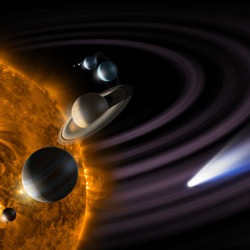
Science
Our pursuit of knowledge concerning the cosmos is still in its early stages, and we are constantly taken aback by any novel revelations.
There are still numerous enigmas to be unraveled, even within our minuscule corner of the universe known as the solar system.
Here are several intriguing pieces of information regarding the loftiest mountain, the most massive asteroid, the biggest entity, and other components of our solar system.
1. The most towering peak
Mount Olympus is an iconic Martian peak that makes Everest look like a mere bump on the ground. Reaching an impressive altitude of 21,900 meters, this majestic volcanic mountain was once believed to be the loftiest in the entire solar system.

Nevertheless, a newly found summit situated on Vesta, one of the most massive celestial bodies in the Milky Way, has dethroned Olympus from its prestigious position. The summit, named Reyasylvia, stands at an impressive height of 22 kilometers, surpassing Olympus by 100 meters.
Due to the inherent limitations of these measurements and the relatively minor disparity between these peaks, it is inconclusive to definitively assert that one is definitively taller than the other.
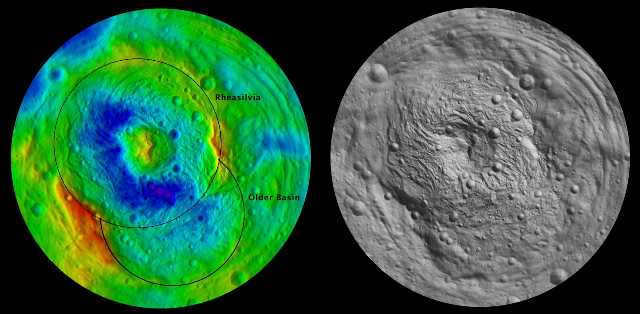
Reyasylvia located on the Vesta asteroid
During the exploration of Vesta by the Dawn spacecraft in 2011, it was discovered that Reyasylvia serves as the central mountain within a colossal crater measuring 505 km in diameter, which is nearly equal in length to the entire asteroid itself.
2. The biggest asteroid
Pallada is known as the biggest asteroid in our solar system, but only in specific conditions.
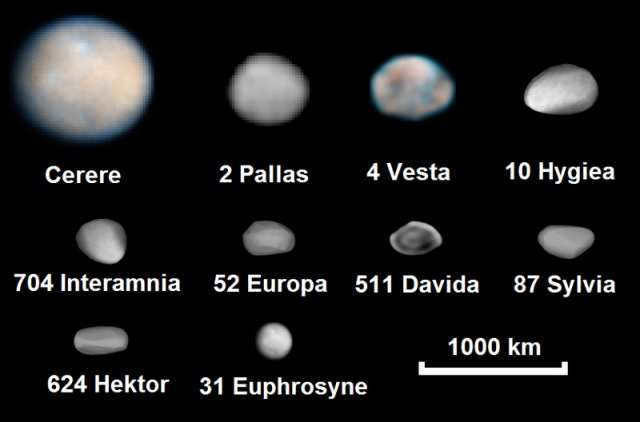
Comparison of large asteroids
First and foremost, it is important to mention Ceres. It was the initial asteroid to be discovered and is significantly larger than the others. It constitutes close to one-third of the overall mass of the asteroid belt. Thus, technically, Ceres could be considered the most sizable asteroid; however, it has been downgraded to the status of a dwarf planet.
In addition, the asteroid Vesta is actually denser than Pallada, although the latter has a larger volume.
Pallada might not hold the distinction of being the largest asteroid for much longer because, according to the latest Hubble images, it is a dynamic protoplanet.
3. The most significant impact crater
At present, there are three contenders vying for the distinction of being the most significant impact crater, and they are all situated on Mars..

The Hellas Plain on Mars
The Hellas Plain is the first and smallest of the three options, measuring 2,300 kilometers in diameter. However, it is the only one known to have been formed by an impact.
The second crater, known as the Utopia Plain, is significantly larger than the previous one. However, both of these craters appear tiny when compared to the largest crater in our solar system.
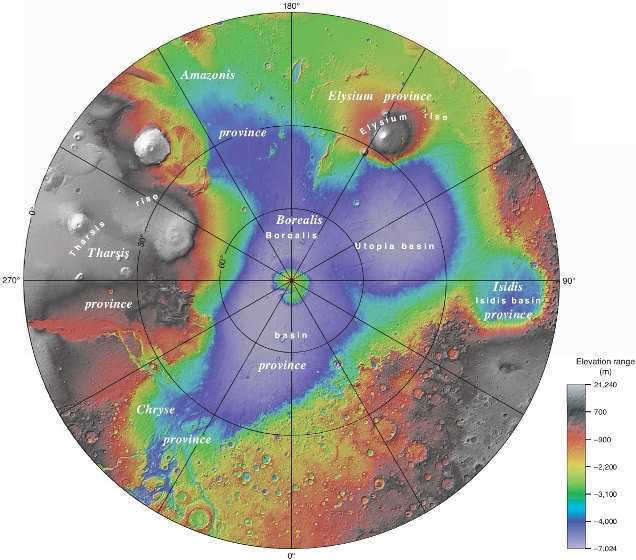
The vast expanse of the Martian Great Northern Plain (located in the center of the planet)
The dimensions of this remarkable geographical feature are an impressive 8,500 kilometers, making it nearly three times larger than the Utopia Plain.
While its origins as an impact crater have not yet been officially confirmed, if this is indeed the case, it would suggest an incredibly powerful impact event occurred, providing valuable insights into the formation and evolution of Mars as a celestial body.
4. The most volcanically active celestial object
Contrary to popular belief, volcanic activity is not widespread throughout the solar system. Although Mars and the Moon exhibit indications of volcanic activity, there are only four other celestial objects that share this characteristic.

Volcanic activity occurring on Io, one of Jupiter’s satellites.
Aside from our own planet, there exist three satellites in the solar system that exhibit volcanic activity: Triton (a moon of Neptune), Io (a moon of Jupiter), and Enceladus (a moon of Saturn).
Out of all these satellites, Io displays the most vigorous volcanic activity. Satellite imagery depicts approximately 150 volcanoes, with astronomers estimating a total count of around 400. It is quite astonishing that any volcanic activity occurs on Io, considering its icy surface and significant distance from the Sun.
One theory posits that internal friction is responsible for Io’s volcanic activity, providing an explanation for how this cold celestial body maintains its intense heat.
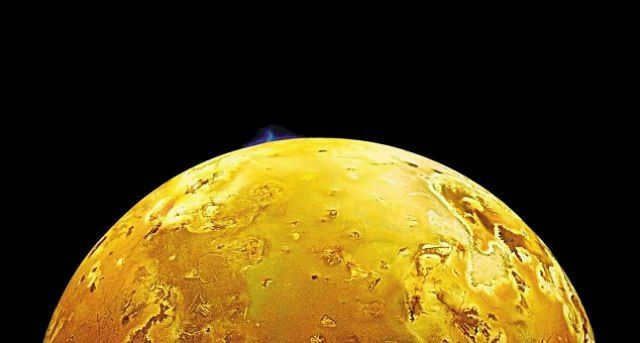
Jupiter’s satellite experiences continuous internal deformation as a result of the external forces exerted by Jupiter and its two massive satellites, Ganymede and Europa. This interaction leads to the formation of internal tidal forces, which generate friction and produce heat to sustain the ongoing volcanic activity.
5. The solar system’s biggest entity
The Sun, accounting for 99 percent of the solar system’s mass, holds the title of being the largest entity in the solar system. However, in 2007, a comet temporarily surpassed the Sun in size.
The comet’s coma, a hazy region encompassing the comet and consisting of ice and dust, is the more probable cause for the comet’s enlargement. Comet 17P/Holmes was first observed in 1892 and received its name in honor of its discoverer, Edwin Holmes.
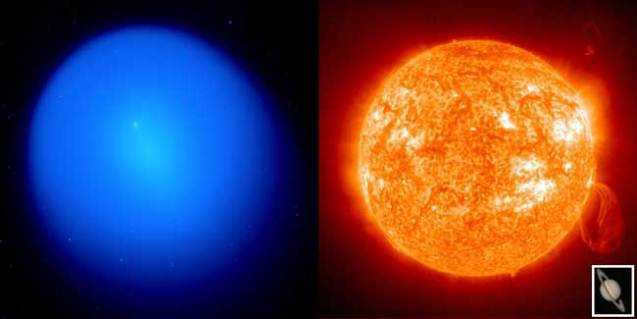
Comparison between Comet 17P/Holmes and the Sun
Scientists have been attempting to monitor it ever since, despite losing track of it for almost six decades between 1906 and 1964.
While it is unusual for a comet to undergo periods of increased brightness, on October 23, 2007, Comet Holmes suddenly experienced a significant surge in brightness, reaching nearly half a million.
This was the most intense flare of the comet that could be seen with the naked eye.
Throughout the following month, the comet continued to expand until it reached a size of 1.4 million kilometers in diameter, officially surpassing the Sun.
The cause of this outburst is still unknown, and it may surprise astronomers many more times in the future.
The Magellan spacecraft was sent to Venus in 1989, where it conducted the most extensive surface mapping ever done. Additionally, in 1991, it made the remarkable discovery of the solar system’s longest known channel.
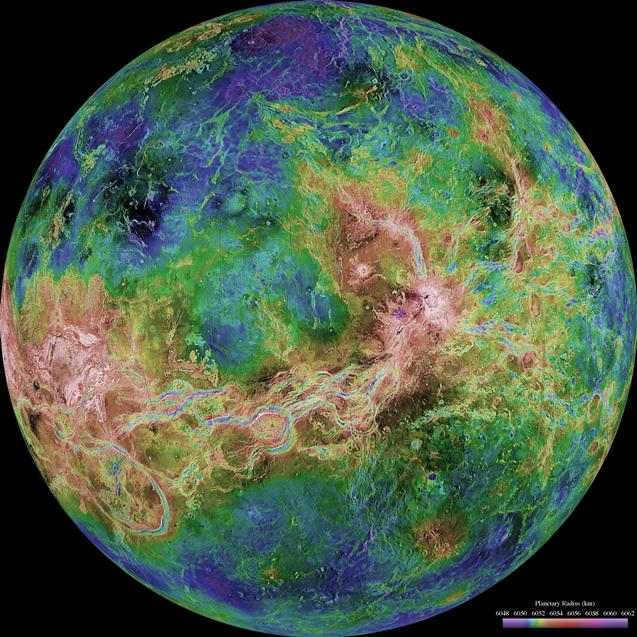
The Baltis Valley was given its name and had a total length of 6,800 kilometers. Numerous channels similar to it have been discovered on Venus, but none of them can compare to the grandeur of the Baltis Valley.
Astronomers are particularly intrigued by the origins of these channels, considering the harsh conditions prevailing on Venus. The planet boasts a surface pressure that is 90 times that of Earth’s, and temperatures can soar up to 462 degrees Celsius.
One theory suggests that these channels were formed by molten lava expelled during volcanic eruptions. Such lava beds are unique to Venus and have no parallel on Earth, although it is plausible that similar formations existed on our planet billions of years ago.
7. The biggest lava lake
As previously stated, Io, a moon of Jupiter, is among the limited number of celestial bodies in our solar system that remains volcanically active, and its volcanic activity is quite intense. The flowing lava needs a place to go, and this frequently leads to the creation of lava lakes.
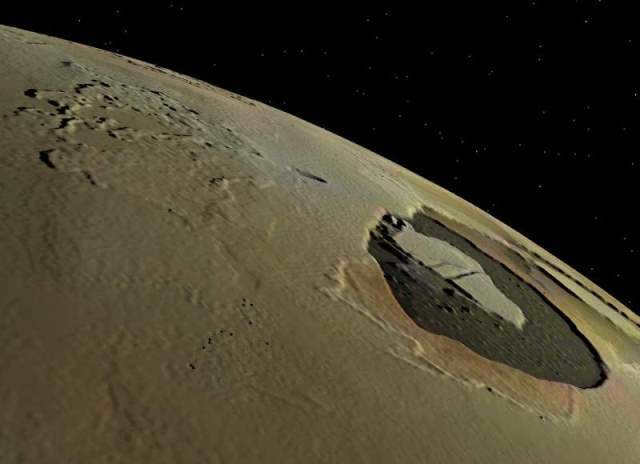
The gigantic crater known as Patera Loki, located on Jupiter’s moon Io, is a truly remarkable sight.
Out of all the lava lakes in the entire solar system, Patera Loki is the most massive one.
While similar phenomena can be found on Earth, none of them are currently active. The largest of these lakes is the Nyiragongo volcano in the Democratic Republic of Congo, which spans approximately 700 meters in diameter.

Nyiragongo volcano on Earth
Nevertheless, there is proof to indicate that the Masaya volcano in Nicaragua has previously developed a lava lake of even greater size, measuring up to 1 km in diameter.
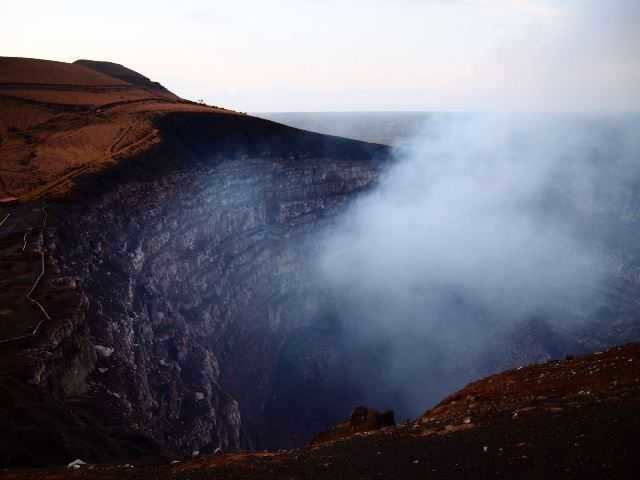
Masaya Volcano on Earth
An external perspective of Patera Loki reveals its immense size, measuring 200 kilometers in diameter. The lake’s surface area, however, is not directly proportional due to its unique U-shape, making it exceptionally large.
In fact, the lake is nearly twice the size of Patera Gish Bar, which is the second largest lava lake on Io, with a diameter of 106 kilometers.
8. The most ancient asteroids
Even though extensive investigations have been conducted, the exact process of asteroid formation still eludes us.
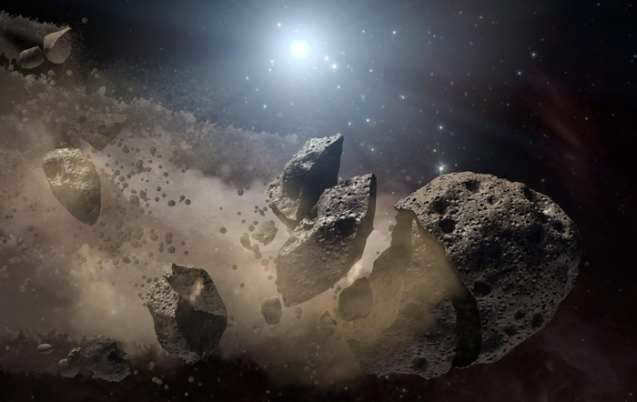
Currently, there are two primary hypotheses regarding the origins of asteroids. One suggests that they were formed through a process similar to planet formation, where chunks of material collided and merged over time. The other theory proposes that asteroids are remnants of ancient planets that once existed between Mars and Jupiter, and their destruction led to the formation of the asteroid belt.
Our understanding of asteroid formation took a significant leap forward in 2008 when astronomers at the Mauna Kea Observatory in Hawaii discovered the oldest known asteroids in our solar system.
These asteroids, estimated to be approximately 4.55 billion years old, are even older than any meteorites that have fallen to Earth. Their age closely aligns with the formation of the solar system itself.
9. The greatest tail of a comet
Comet Hyakutake or The Phenomenal Comet of 1996 gained fame for possessing the most extensive tail ever witnessed.
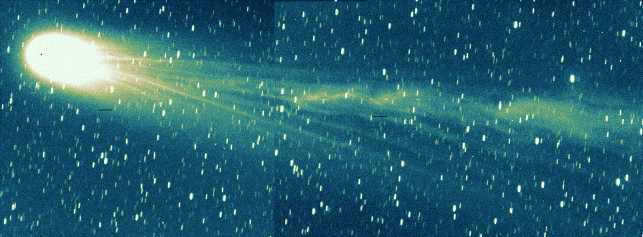
Hyakutake or the Great Comet of 1996
When Hyakutake made its way past Earth in 1996, it came closer than any other comet. The comet shone brightly and could be seen with the naked eye.
Furthermore, its tail kept growing until it became the longest tail in history, measuring a total of 560 million kilometers.
The previous record was set by the Great Comet of 1843, which had a tail length of 300 million kilometers, equivalent to about two astronomical units.

The Amazing Comet of 1843
Hyakutake has also given us valuable insights into the creation of our solar system. Through chemical examination, it was revealed that the comet contained ethane and methane. This discovery marked the first occasion where such gases were identified within a comet, suggesting the presence of multiple comet variations.
10. The Most Enigmatic Weather Phenomenon
As the biggest planet in our solar system, Jupiter offers a unique opportunity to witness some truly remarkable atmospheric events.
While the massive hurricane called the Great Red Spot is well-known, there is another intriguing feature that can be seen in pictures of Jupiter – two crimson stripes stretching across the planet in parallel.
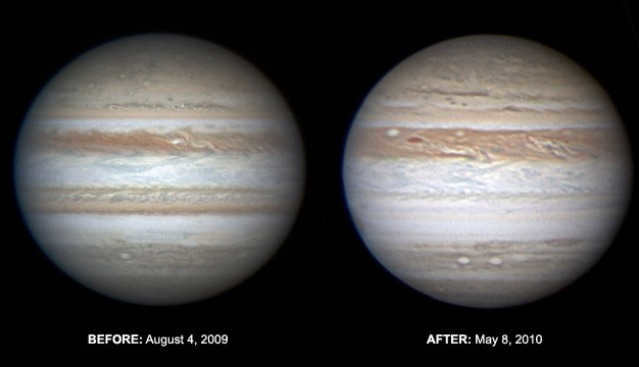
The Southern Equatorial Belt of Jupiter observed in 2009 and 2010
In May 2010, an unusual event occurred with the lower band, the Southern Equatorial Belt. It completely vanished, leaving astronomers puzzled and searching for an explanation. Various assumptions were made until November 2010 when the belt reappeared.
Infrared images revealed that the belt had started to regain its characteristic red-brown color. Experts speculate that the appearance of white clouds formed from ammonia ice, which are situated above the brown clouds, may have obscured the belt from view.
This phenomenon seems to occur approximately once every few decades and typically lasts for about a year.
Nevertheless, there is still much to discover regarding the reasons behind its occurrence. To the best of our knowledge, this phenomenon is the sole example within the entire solar system. It’s worth noting that Jupiter’s Northern Belt does not experience such alterations.
For the past three centuries, Saturn has been renowned as the planet with rings. However, all gas giant planets possess rings, albeit the rings of Jupiter, Uranus, and Neptune were only recently detected. In this tutorial from TEACHER, we will explore the primary characteristics of the ringed planets in the solar system.
- General traits of the ringed planets in the solar system
- Jupiter, one of the ringed planets in the solar system
- Saturn’s rings
- Uranus and its rings
- Neptune and its rings
Overview of the ringed planets in our solar system
The solar system is home to four gas giant planets with distinctive rings: Saturn, Jupiter, Uranus, and Neptune.
While each of these planets has its own unique qualities, they all share some common characteristics:
- Gaseous composition: These planets are primarily composed of massive amounts of gas, lacking a solid surface. It is believed that they have a solid core, concealed beneath a thick layer of clouds.
Jupiter, one of the planets with rings in the solar system.
Jupiter is the biggest planet in our solar system and the fifth largest when compared to the Sun. Similar to the other outer planets in our solar system, it is a gas giant. It has a composition that is similar to that of the Sun, primarily made up of hydrogen and helium. As a result, Jupiter shares the same composition as a star, but it lacks the necessary mass to undergo nuclear fusion and become a star with its own light.
Due to its composition of a mixture of gases and liquids, Jupiter does not have a solid surface. It is still uncertain whether the planet has a solid core or if it is made up of a dense fluid consisting of iron and silicate minerals at high temperatures.
Jupiter’s atmosphere is a great enigma. It is where the bands of the atmosphere extend from east to west and remain stable. These bands consist of various layers of clouds that envelop the entire planet, creating its distinctive white, brown, and ochre stripes that run parallel to the equator.
Moreover, Jupiter’s atmosphere experiences intense meteorological phenomena, fueled by the planet’s radiant heat and reaching immense proportions. Among these phenomena is the well-known Red Spot, a massive storm core on Jupiter with a diameter 2.5 times that of Earth and wind speeds exceeding 500 km/h.
Furthermore, Jupiter boasts a quartet of sizable moons (Io, Ganymede, Callisto, and Europa) and a multitude of smaller satellites.
The planet has a vast magnetic field, known as a magnetosphere, which is significantly stronger than Earth’s magnetic field, ranging from 16 to 54 times more powerful.
Jupiter’s ring system
The rings surrounding Jupiter are incredibly faint, making them difficult to observe until the Voyager space probe approached Jupiter approximately two decades ago.
Jupiter’s ring system has a diameter twenty times larger than Earth’s and a radial width equivalent to Earth’s diameter. The proportions are similar to a bicycle tire. However, unlike other planets, Jupiter’s rings are not composed of ice crystals but rather dust particles. These particles are mostly micrometer in size, similar to the diameter of a human hair.
There are indications that the rings of Jupiter were created by the impact of meteorites on the innermost moons of the planet.
The Rings of Saturn
Saturn, the sixth planet in the solar system, is also known for its magnificent rings. It is the second largest planet in our solar system and has a distinct flattened shape due to its rapid rotation.
Similar to Jupiter, Saturn is primarily composed of hydrogen and helium. It lacks a solid surface and is instead a massive sphere comprised of gases and liquids. It remains uncertain whether there is a solid core at its center.
In the atmospheric conditions of Saturn, a distinct arrangement of cloud bands can be observed, which bears resemblance to that of Jupiter, although it appears less prominent. Within the higher layers of the atmosphere, there exist disruptive occurrences akin to hurricanes, with wind speeds surpassing 500 m/s in close proximity to the planet’s equator. Much like Jupiter, Saturn has also witnessed the occurrence of immense storms, such as the widely known great white spot that was first identified in 2010 and subsequently evolved into a phenomenon encompassing the entire planet.
It’s a distinctive planet encircled by a multitude of rings composed of ice and rocks. The particles constituting Saturn’s rings exhibit a wide range in dimension, ranging from minuscule specks of dust to massive mountains. The formation of Saturn’s rings is believed to have occurred through the interaction with comets, asteroids, or moons that were drawn in by the planet’s immense gravitational force, disintegrating before ever reaching its surface.
The magnificent ring system of Saturn
Saturn boasts an awe-inspiring structure known as its ring system, which is considered one of the most remarkable features in our solar system. This system consists of a total of seven distinct rings that are adorned with numerous gaps and separations throughout. Spanning an impressive area of 282 thousand kilometers and measuring approximately 10 meters in thickness, Saturn’s rings truly captivate the imagination.
While the rings are generally closely packed together, there is an intriguing empty space known as the Cassini Compartment that stretches across about 4,700 kilometers. This compartment serves as a physical divider between the system’s main rings, namely the A ring and the B ring. Each of these rings orbits Saturn at a different velocity, contributing to the overall dynamic nature of this celestial phenomenon.
Interestingly, recent findings from paleontologists suggest that Saturn’s rings are not permanent structures. Instead, they appear to be ephemeral in comparison to the lifespan of the planet itself. This discovery highlights the ever-evolving nature of Saturn’s ring system and adds to its allure.
While it was previously believed that Saturn’s rings emerged during the creation of the solar system, current knowledge reveals that their formation is relatively recent, occurring only a few hundred million years ago. Furthermore, these rings gradually disintegrate over time.
Calculations suggest that Saturn’s rings shed approximately one ton of water ice per second, which ultimately descends onto the planet’s surface. Therefore, it is plausible that Saturn’s rings may vanish entirely within the next 300 million years.
Uranus is the seventh planet from the sun and the third largest planet in our solar system. It is one of two frigid planets in the solar system, the other being Neptune. Uranus has a chilly and gusty atmosphere, with winds that resemble those on Earth. It is characterized by a polar flattening caused by its rapid rotation. The planet has a bluish green hue due to the presence of methane in its atmosphere.
One of the most distinctive features of Uranus is its tilted axis of rotation, which is highly inclined. As a result, the planet’s axis of rotation is oriented towards the Sun. Additionally, similar to Venus, Uranus orbits the Sun in the opposite direction to most other planets, moving from east to west. This peculiar behavior is likely the result of a collision with an asteroid or another celestial object.
Due to its tilted axis of rotation, Uranus has an irregularly shaped magnetosphere. It boasts a total of 27 moons, but none of them possess any remarkable features.
The Ring System of Uranus
Uranus’ ring system was discovered in 1977 and is composed of two sets.
- The inner rings are narrow and dark gray.
- The second set consists of two outer rings, with the innermost ring having a reddish hue and the outermost ring appearing bluish.
Several of the larger rings are surrounded by dust belts. The exact composition of the particles comprising Uranus’ rings remains unknown. However, one of these rings (Epsilon) is composed of a rock approximately the size of a golf ball, with a notable absence of dust particles.
The narrow and dark appearance of Uranus’ inner rings is believed to be caused by the presence of small moons that orbit the planet between these rings. These interlunar satellites exert gravitational influences on the rings, resulting in their narrow and sharply defined edges.
The formation of these rings could be attributed to various factors, such as the capture of asteroid debris by Uranus’ gravitational force, the collision of two moons leading to debris formation, the disintegration of moons when they approached the planet too closely, or remnants from the planet’s own formation.
Neptune and the Rings around It
Neptune is the final planet in the solar system that is adorned with rings. Additionally, it holds the title of being the farthest planet from the Sun. This gas giant is shrouded in darkness and extreme cold, constantly battered by powerful winds. Neptune is one of the two icy giants in our solar system, with the other being Uranus.
Although Neptune is slightly smaller than Uranus, it shares similar structure and characteristics. Moreover, Neptune boasts a considerable number of moons (14), with the largest one being Triton, which is just a tad smaller than Earth’s moon.
In addition to hydrogen and helium, Neptune’s atmosphere also contains trace amounts of methane gas and other yet-to-be-identified components. These additional components contribute to the planet’s distinctive bright blue color, which sets it apart from Uranus. Similar to other ringed planets, Neptune’s atmosphere experiences extreme weather conditions, including powerful winds reaching speeds exceeding 2000 km/h and violent storms. One notable storm, known as the “Great Dark Spot,” was observed in the planet’s southern hemisphere in 1988. This storm was as large as Earth itself.
Neptune’s planetary ring system is incredibly delicate and fragile. It is hypothesized to consist of tiny particles of dust and fragments of rock. The system is composed of a minimum of 5 primary rings that are narrow and dark in color.
Furthermore, the ring system is comprised of four arcs which are clusters of dust believed to be stable as a result of the gravitational pull from Galatea’s moon.
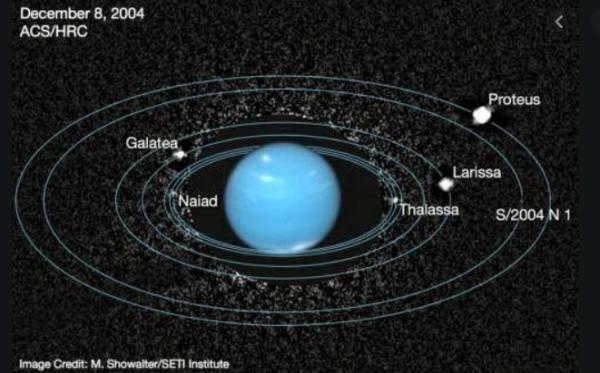
If you are interested in learning more about Planets with Rings in the Solar System, we suggest browsing through our Astronomy section.
- Gregor Morfill. (1996). The Origins of Jupiter’s Ring: A Fascinating Mystery. Astronomy Research and Science. Barcelona: Scientific Press S.L.
- Simon Cabanes, Benjamin Favier, Michael Le Bars. (2018). Unraveling the Enigma of Jupiter’s Stripes. Solar System, Research and Science. Barcelona: Scientific Press S.L.
- James O’Donoghue et al. Exploring the Chemical and Thermal Effects of Ring Rain in Saturn’s Ionosphere., Ikarus, in press (online November 6, 2018).
- Andrew P. Ingersoll (1999). Uranus. Themes I and C. Barcelona: Scientific Press S.L.
- Jeffrey N. Cuzzi and Larry W. Esposito (1987). The rings of Uranus. Astronomy Research and Science. Barcelona: Scientific Press S.L.
- The hidden mysteries of Epsilon, the enigmatic ring of Uranus. (2019). National Geographic Spain.nationalgeographic.com.
- Julio Solis Garcia (2015). Atmospheres of the planets in the solar system. Statistical Agency for Meteorology. Madrid: Yearbook of the Astronomical Observatory of Madrid.
- Jun Kinoshita (1990). Neptune. Astronomical research and science. Barcelona: Scientific Press S.L.
When it comes to the group of planets that exist in our solar system, known as the terrestrial planets, there are a few interesting things to note. This group includes the planets Mercury, Venus, Earth, and Mars. What sets Mercury and Venus apart from the others is the fact that they do not have any natural satellites orbiting around them. Earth, on the other hand, has one natural satellite, while Mars has two: Phobos and Deimos.
However, the gas giants of our solar system, which include Jupiter, Saturn, Uranus, and Neptune, have a much more fascinating satellite situation. Due to their larger mass and stronger gravity, these planets have been able to capture larger objects into their orbits. Out of the gas giants, Jupiter is the largest planet in the solar system and has the highest number of known satellites. To date, astronomers have identified 79 satellites orbiting around Jupiter. Saturn comes in second with 62 satellites, while Uranus has 27 and Neptune has 14.
There are still many satellites that remain unknown to astronomers, and it is possible that some may even support life. However, what we do know at this time is their estimated size. Presented below is a compilation of the 10 largest planetary satellites in our solar system.
10 Oberon
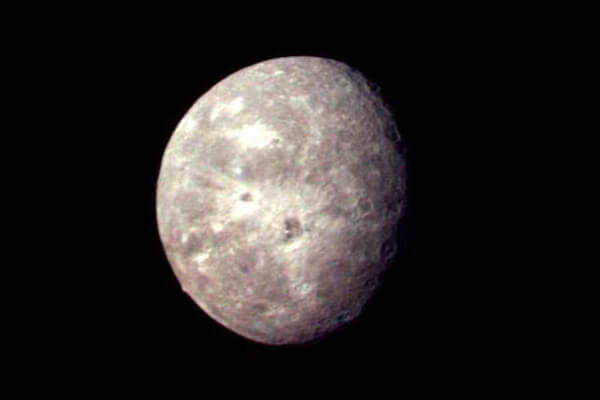
- Diameter: 1523 kilometers
- Satellite: Uranus
- Date of discovery: January 11, 1787.
- Period of orbit: 13,463 days.
- Mass: 3,014 × 10,21 kg
- Acceleration of free fall: 0.346 m/s 2
- Surface temperature: -203 °C … -193 °C
Oberon is the second largest and most massive moon of Uranus, and it is also the ninth largest and tenth largest moon in the entire solar system. It is also known as Uranus IV and was discovered by William Herschel on January 11, 1787. It is named after the king of fairies and elves from William Shakespeare’s A Midsummer Night’s Dream. Oberon is the farthest moon from Uranus among its major satellites, and its orbit partially extends outside of Uranus’ magnetosphere.
The surface of Oberon has a dark appearance with a reddish hue. The landscape of Oberon was primarily shaped by the impact of asteroids and comets, resulting in the formation of numerous large craters, some reaching up to 210 kilometers in diameter. Additionally, Oberon features a network of canyons that formed when the crust stretched due to internal expansion during its early history.
Researchers speculate that there might be a liquid ocean located at the boundary between Oberon’s core and mantle. This potential ocean, if present, could have a thickness of approximately 40 kilometers.
9 Rhea
can be paraphrased as “The ninth moon of Saturn is known as Rhea.”
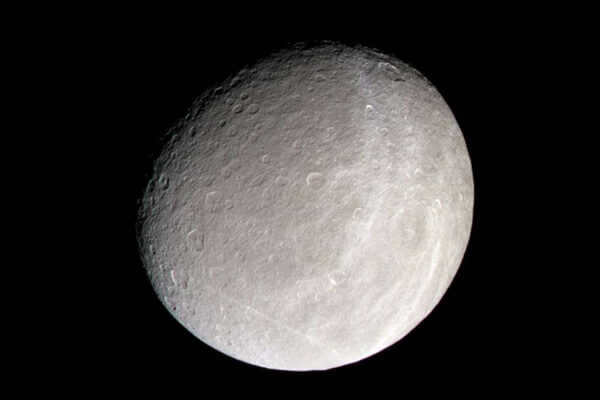
- Diameter: 1,527 kilometers
- Satellite: Saturn
- Date of discovery: December 23, 1672.
- Orbital period: 4,518 days.
- Mass: 2,306 × 10,21 kg
- Gravity: 0.264 m/s 2
- Surface temperature: -230 °C … -170 °C
Rhea is the second largest moon of Saturn, the ninth largest and tenth largest moon in the solar system by mass. It is the fifth farthest from Saturn among its seven major moons.
Rhea’s terrain is made up of a combination of frozen water and rocky formations, accounting for less than 1/3 of the moon’s overall mass. As of 2020, there have been 128 officially named craters, 6 chains of craters and their associated groups, 5 canyons and their associated groups, as well as 2 furrows and 2 lines on Rhea’s surface.
8 Titania
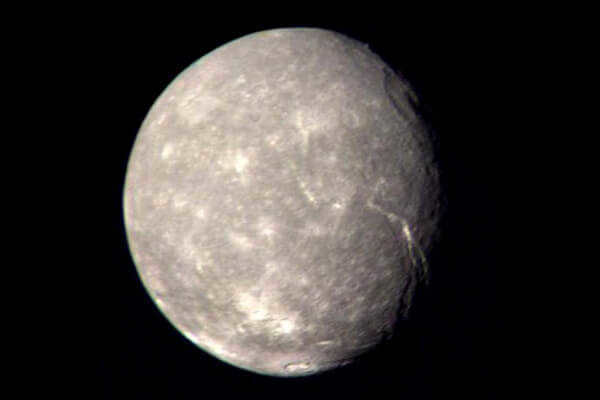
- Diameter: 1577 km.
- Satellite: Uranus
- Date of discovery: January 11, 1787.
- Period of orbit: 8,706 days.
- Mass: 3,527 × 10,21 kg
- Free-fall acceleration: 0.379 m/s 2
- Surface temperature: -213 °C … -184 °C
Titania is the largest moon of Uranus and the eighth largest moon in the solar system. It was discovered by William Herschel on January 11, 1787, which was 6 years after his discovery of Uranus. It is named after the Fairy Queen from William Shakespeare’s play A Midsummer Night’s Dream. Titania is the fourth farthest moon from Uranus among its five major moons. Its orbit is entirely within Uranus’ magnetosphere.
Titania most likely originated from the accretion disk that surrounded Uranus during its formation, just like the other largest moons of the planet. It is believed that Titania is made up of roughly equal amounts of rock and ice, and it is thought to have a differentiated structure with a rocky core and an icy mantle. It is also speculated that there may be a layer of liquid water at the boundary between the core and mantle.
The Voyager 2 spacecraft, which explored the Uranus system in 1986, provided the only close-up images of Titania that are currently available. No other spacecraft has had the opportunity to visit Uranus or its moon Titania. However, there are ongoing discussions and evaluations of potential missions to explore Uranus and its moons in the future.
7 Triton
Triton is the seventh-largest moon of the planet Neptune. It was discovered by British astronomer William Lassell in 1846, just 17 days after the discovery of Neptune itself. Triton is unique among the moons of our solar system because it orbits Neptune in a retrograde direction, meaning it moves in the opposite direction of Neptune’s rotation. It is also the only large moon in our solar system to have a substantial atmosphere. Triton’s atmosphere is composed mainly of nitrogen, with traces of methane and carbon monoxide. The surface of Triton is covered in a layer of ice, and there are geysers that erupt nitrogen gas from beneath the surface. Triton is thought to have been captured by Neptune’s gravity from the Kuiper Belt, a region of icy bodies beyond the orbit of Neptune. The capture of Triton may have caused the migration of other moons in Neptune’s system and the destruction of a previous generation of moons.
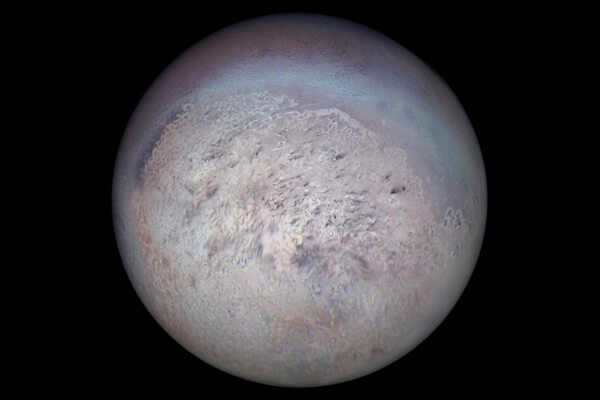
- Diameter: 2706 km.
- Satellite: Neptune
- Date of discovery: October 10, 1846.
- Circulation period: 5.88 days (retrograde motion).
- Mass: 2.14 × 10 22 kg.
- Free-fall acceleration: 0.779 m/s 2
- Surface temperature: -235 °C
Triton is the largest moon of Neptune, which was discovered by the English astronomer William Lassell on October 10, 1846. It is the seventh largest moon in the Solar System and the only major moon in the Solar System with retrograde (backward) orbital motion. Due to its retrograde motion and similar composition to Pluto, it is believed to have been captured from the Kuiper Belt.
The satellite was given the name Triton in tribute to the ancient Greek god Triton, who was the son of Poseidon. While William Lassell was involved in the discussion regarding the names of certain planetary satellites (Hyperion, Ariel, Umbriel), he did not officially name Triton. The name Triton was first mentioned by Camille Flammarion in 1880, but it was not adopted until many years later. Prior to 1949, Triton was simply referred to as Neptune’s Companion until the discovery of the planet’s second satellite, Nereid.
Despite having an atmosphere, Triton’s surface is so thin that it provides no practical use. Being on the surface without a properly insulated spacesuit would be fatal. The average temperature on Triton’s surface is -235 °C.
6 Europa
Rephrase the text, making it unique, using the English language and preserving the HTML markup:
6 Europa
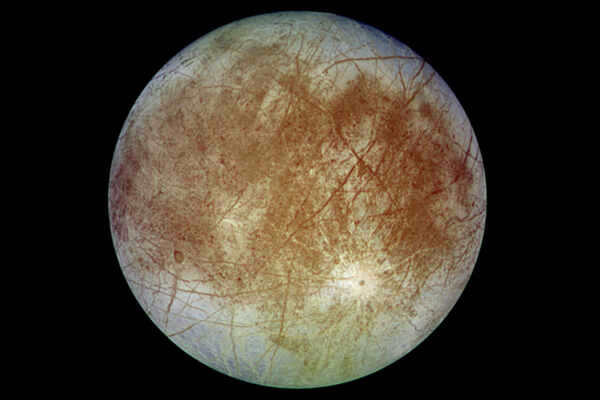
- Diameter: 3122 kilometers
- Satellite: Jupiter
- Date of discovery: January 8, 1610.
- Circulation period: 3,551 days.
- Mass: 4,802 × 10,22 kg
- Acceleration of free fall: 1.315 m/s 2
- Surface temperature: -223 °C … -163 °C
Europa (or Jupiter II) – the sixth most distant satellite of Jupiter, and it is also the smallest among the four Galilean satellites. It was discovered in 1610 by Galileo Galilei, and it is believed that Simon Marius also discovered it around the same time. Over the years, Europa has been observed more and more with telescopes, and since the 1970s, it has been explored by spacecraft that have flown close to it.
Simon Marius coined the term Europa in 1614, although Johannes Kepler had previously suggested it. The moon is named after a figure from Greek mythology, the daughter of the Phoenician ruler of Tyre and a lover of Zeus (Jupiter). It is believed that the name Europa is derived from the Phoenician word meaning “sunset”. However, the name Europa, along with the names Marius proposed for the other Galilean moons, was not widely used until the mid-20th century.
Europa’s composition is primarily made up of silicate rocks, with an iron core located in its center. The surface is covered in ice and is exceptionally smooth compared to other celestial bodies in our solar system. Although there are very few craters, there are numerous cracks present. The surface’s youthful appearance and smoothness have led scientists to theorize that there may be an ocean of water beneath it, which could potentially harbor microscopic life. It is believed that tidal forces prevent the water from freezing, as the periodic changes in these forces cause the satellite to deform and generate heat within its interior. This phenomenon also accounts for Europa’s geologic activity, which resembles plate tectonics. Additionally, Europa possesses an extremely thin atmosphere, primarily composed of oxygen.
5 Celestial Body
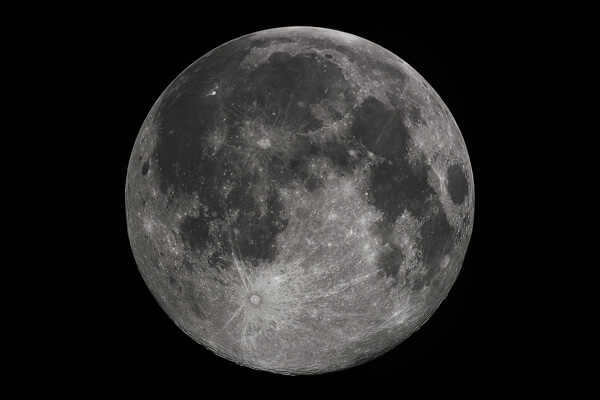
- Diameter: 3475 km.
- Satellite: Earth
- Circulation period: 27,321 days
- Mass: 7.3477 × 10,22 kg
- Free-fall acceleration: 1.62 m/s 2
- Surface temperature: -173 °C … +117 °C
The Moon – is Earth’s only natural satellite. It is the closest planetary satellite to the Sun, as the planets closest to the Sun (Mercury and Venus) do not have moons. The Moon is the second brightest object in the Earth’s sky after the Sun and the fifth largest natural satellite of a planet in the Solar System. The average distance between the centers of the Earth and the Moon is 384,467 km (~30 Earth diameters).
The Moon emerged approximately 4.51 billion years ago, slightly after the Earth. The prevailing theory suggests that the Moon was formed from remnants remaining after the “Giant Collision” between Earth and Teia, a planet of similar size to Mars. The Moon stands as the solitary extraterrestrial celestial body that has been explored by humans.
The Russian term “Luna” originates from the Praslavl word meaning “light.” The Greeks referred to the Earth’s satellite as Selene, the ancient Egyptians called it Yah, the Babylonians named it Shin, and the Japanese referred to it as Tsukiyomi.
4 Io
4 Input/Output
4 Input and Output
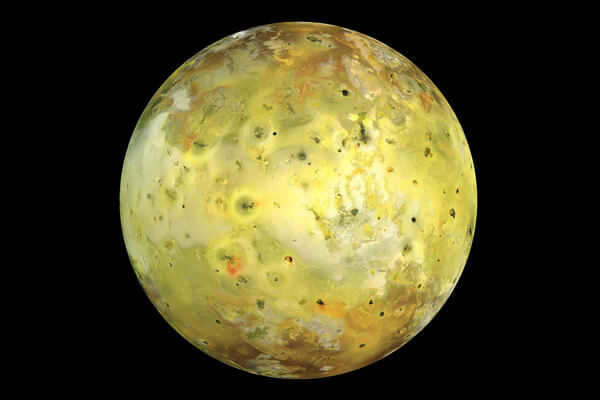
- Size: Io has a diameter of 3,642 kilometers
- Orbit: It is a satellite of Jupiter
- Discovery: Io was discovered on January 8, 1610.
- Revolution: It takes Io approximately 1,769 days to complete one orbit around Jupiter.
- Mass: Io has a mass of 8.9319 × 10 22 kg
- Gravity: The free-fall acceleration on Io is 1.796 m/s 2
- Temperature: The surface temperature of Io ranges from -183 °C to -143 °C
Io is one of Jupiter’s moons, and it is the closest moon to the planet out of the four Galilean satellites. It gets its name from the mythological character Io, who was a priestess of Hera and the lover of Zeus. With a diameter of 3,642 kilometers, Io is the fourth largest moon in our solar system.
Io plays a crucial role in shaping the magnetic field of Jupiter. The magnetosphere of Jupiter absorbs gases and particles from the thin atmosphere of Io at a rate of 1 ton per second. This material primarily consists of ionized and neutral sulfur, oxygen, and chlorine, as well as atomic sodium and potassium. Additionally, there are molecular sulfur and sulfur dioxide, along with sodium chloride dust. These substances are ejected by the volcanoes on Io, then they enter its atmosphere, and eventually find their way into Jupiter’s magnetosphere and occasionally into interplanetary space. Depending on their composition and degree of ionization, all these materials end up in different neutral clouds and radiation belts within the magnetosphere of Jupiter, and some may even escape the Jupiter system entirely.
3 Callisto
Rewrite the text to make it unique while preserving the HTML markup:
3 Callisto
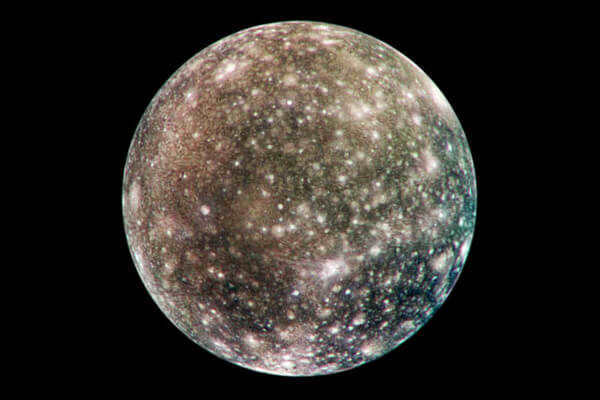
- Diameter: 4821 km.
- Satellite: Jupiter
- Date of discovery: January 7, 1610.
- Circulation period: 16,689 days.
- Mass: 1.075 × 10,23 kg
- Free-fall acceleration: 1.235 m/s 2
- Surface temperature: -193 °C … -108 °C
Callisto is the second largest moon of Jupiter (after Ganymede), one of the four largest moons discovered by Galileo Galilei in 1610. It is the third largest moon in the entire Solar System. It was named after Callisto, a character from Greek mythology who was the mistress of Zeus.
Because Callisto has low levels of background radiation and is large in size, it is frequently suggested as a potential location for a station that would enhance humanity’s exploration of the Jupiter system. In 2003, NASA conducted a conceptual study called HOPE – “Hope” – which examined the future of humanity’s exploration of the outer solar system. Callisto was one of the specific targets that received detailed analysis. The study proposed the construction of a station on the moon to process and generate fuel from the surrounding ice, which could then be used by spacecraft traveling to more distant regions of the solar system. Additionally, the ice could serve as a source for extracting water.
Similar to Europa and Ganymede, there is a widespread belief that there could be extraterrestrial microbial life in Callisto’s subsurface ocean. However, the conditions for life on Callisto are slightly more challenging compared to Europa or Ganymede. The primary factors contributing to these less favorable conditions include the limited interaction with rocks and lower heat flow from the satellite’s interior.
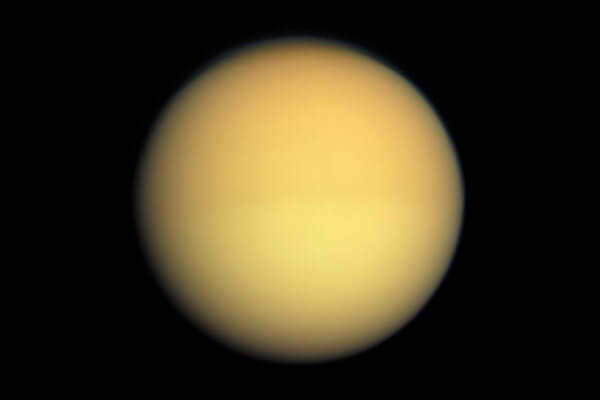
- Diameter: 5152 km.
- Satellite: Saturn
- Date of discovery: March 25, 1655.
- Circulation period: 15.945 days.
- Mass: 1,345 × 10,23 kg
- Free-fall acceleration: 1.352 m/s 2
- Surface temperature: -179 °C
Titan – Saturn’s largest moon and the second largest moon in the solar system, is the only celestial body in the solar system, apart from Earth, where the presence of liquid on the surface has been confirmed. It is also the only moon of a planet with a dense atmosphere. Titan was first observed by Dutch astronomer Christiaan Huygens on March 25, 1655.
Titan, which is roughly the same size as Mercury and Ganymede, boasts an expansive atmosphere that measures over 400 km in thickness. Scientists believe that this atmosphere is composed of 95% nitrogen and exerts a surface pressure 1.5 times that of Earth’s atmosphere. The presence of methane in Titan’s atmosphere triggers photolysis reactions in the upper layers, resulting in the formation of multiple layers of hydrocarbon “smog”. As a result, Titan stands out as the sole moon in our solar system whose surface cannot be observed using optical range technology.
Given that Saturn and its moons are located outside of the habitable zone, it is theoretically impossible for highly organized life forms (similar to those found on Earth) to emerge. However, scientists have not ruled out the possibility of simpler organisms emerging. The dense nitrogen atmosphere and the presence of organic compounds are being studied by exobiologists, as these conditions may have existed on early Earth. Nevertheless, the low temperatures on Saturn prevent the development of prebiotic life, in contrast to Earth. Nonetheless, in the extremely distant future, the conditions on Titan could undergo significant changes. In approximately 6 billion years, the Sun will have expanded in size and transformed into a red giant, resulting in a surface temperature on the moon of -70 °C, which is sufficiently high for the existence of a liquid ocean composed of a mixture of water and ammonia. These conditions could persist for several hundred million years, providing ample time for the development of relatively complex life forms.
1 Ganymede
can be paraphrased as
1 The moon Ganymede
or
1 The celestial body Ganymede
.
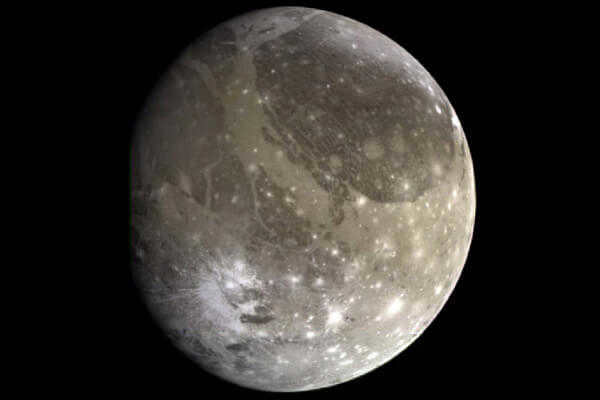
- Diameter: 5268 kilometers.
- Satellite: Jupiter
- Date of discovery: January 7, 1610.
- Orbital period: 7.154 days.
- Mass: 1.482 × 10,23 kilograms
- Acceleration due to gravity: 1.428 m/s 2
- Surface temperature: -203 °C … -121 °C
Ganymede was first observed by Galileo Galilei on January 7, 1610, and it was later suggested by Simon Marius to be named after the cupbearer Ganymede. The initial exploration of Ganymede was carried out by the Pioneer 10 spacecraft in 1973, but it was the Voyager program vehicles in 1979 that provided more in-depth studies. The Galileo spacecraft, which has been examining the Jupiter system since 1995, made significant discoveries such as Ganymede’s underground ocean and magnetic field. In 2012, the European Space Agency approved a new mission called JUICE to investigate Jupiter’s icy satellites, including Ganymede. This mission is set to launch in 2022 and reach the Jupiter system in 2030.

